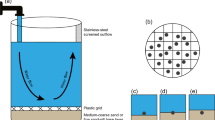Abstract
Lake Piediluco is a naturally regulated lake used for hydroelectric purposes. Management of the lake and the eutrophic conditions of its waters have had a negative impact on fish populations, particularly that of Eurasian perch (Perca fluviatilis L.). In order to increase the natural reproduction of this species, an experimental program was undertaken from 1997 to 2003 to facilitate reproduction by providing artificial spawning substrates. In Lake Piediluco perch spawn from March to May. Egg ribbons ranged in length from 30 to 180 cm and contained from 12,740 to 205,466 eggs. The fraction of degenerated eggs ranged from 0.20% to 63.30% (average 10.20%). The results demonstrate the effectiveness of artificial substrates as suitable substrates for the reproduction of perch.


Similar content being viewed by others
References
Anttilla, R., 1973. Effect of sewage on the fish fauna in the Helsinki area. Oikos 15: 226–229.
Bergman, E., 1990. Effect of roach Rutilus rutilus on two percids, Perca fluviatilis and Gymnocephalus cernua: importance of species interactions for diet shift. Oikos 57: 241–249.
Carosi, A., M. Dörr, G. Giovinazzo, M. Lorenzoni & M. Mearelli, 1998. Gymnocephalus cernuus (Linnaeus, 1758) (Osteichthyes, Percidae) nel bacino del fiume Tevere. Quaderni ETP 27: 103–108.
Craig, J. F. & C. Kipling, 1983. Reproduction effort versus the environment; case histories of Windermere perch, Perca fluviatilis L., and pike, Esox lucius L. Journal of Fish Biology 22: 713–727.
Cioffi, F. & F. Gallerano, 2000. Response of Lake Piediluco to the change of hydrodynamic condition and nutrient load reductions. Ecological Modelling 135: 199–229.
Dörner, H., S. Berg, L. Jacobsen, S. Hüllsmann, M. Brojerg & A. Wagner, 2003. The feeding behaviour of large perch Perca fluviatilis (L.) relation to food availability: a comparative study. Hydrobiologia 506–509: 427–434.
ENEL, 1989. Indagini per la valorizzazione ambientale del lago di Piediluco. Rapporto finale. Enel-DCO, Laboratorio di Piacenza: 56.
Gillet, C. & J. P. Dubois, 1995. A survey of the spawning of perch (Perca fluviatilis), pike (Esox lucius), and roach (Rutilus rutilus), using artificial spawning substrates in lakes. Hydrobiologia 300/301: 409–415.
Giovinazzo, G., 1988. La pesca e l’accrescimento di Perca fluviatilis L. Rivista di Idrobiologia 27: 729–740.
Hartmann, J., 1977. Fischereiliche Veränderungen in kulturbedingt eutrophierenden Seen. Schweiz Z., Hydrologia 39(2): 243–254.
Hartman, K. J. & F. J. Margraf, 2006. Relationships among condition indices, feeding and growth of walleye in Lake Erie. Fisheries Management and Ecology 13: 121–130.
Holmgren, K. & M. Appelberg, 2001. Effects of environmental factors on size-related growth efficiency of perch, Perca fluviatilis. Ecology of Freshwater Fish 10: 247–256.
Houthuizen, R. P., J. J. G. M. Backx & A. D. Buijse, 1993. Exceptionally rapid growth and early maturation of perch in freshwater lake recently converted from an estuary. Journal of Fish Biology 43: 320–324.
Mearelli, M., 1988. Eutrofizzazione. Rivista di Idrobiologia 27: 651–661.
Melotto, S., 1996. Studio sul successo riproduttivo del persico reale, Perca fluviatilis (L.), nel lago di Garda. Atti del VI Convegno Nazionale AIIAD: 505–512.
Pace, R., A. Carosi, M. Corboli, G. Pedicillo, A. Trusso & M. Lorenzoni, 2006. Biologia riproduttiva dell’acerina Gymnocephalus cernuus (Linnaeus, 1758) nel lago di Piediluco. Biologia Ambientale 20(1): 321–324.
Paukert, C. P. & D. W. Willis, 2001. Comparison of exploited and unexploited yellow perch Perca flavescens (Mitchill) popolations in Nebraska Sandhill lakes. Fisheries Management and Ecology 8: 533–542.
Persson, L., 1983. Effects of intra and interspecific competition on dynamic and size structure of a perch Perca fluviatilis and a roach Rutilus rutilus. Oikos 41: 126–132.
Persson, L., 1986. Effects of reduced interspecific competition on resource utilization in perch Perca fluviatilis. Ecology 67: 335–354.
Sandstrom, O. & P. Karas, 2002. Test of artificial substrata as nursey habitat for young fish. Journal of Applied Ichthyology 18: 102–105.
Sandström, O., P. Karås & E. Neuman, 1991. Pulp mill effluent effects on species distributions and recruitment in Baltic coastal fish. Finnish Fisheries Research 12: 101–110.
Sandström, O., I. Abrshamsson, J. Andersson & M. Vetemaa, 1997. Temperature effects on spawning and egg development in Eurasian perch. Journal of Fish Biology 51: 1015–1024.
Shafy, M. & P. S. Maitland, 1971. The age and growth of perch (Perca fluviatilis L.) in two Scottish lochs. Journal of Fish Biology 3: 39–57.
Smith, C., A. Douglas & P. Jurajda, 2000. Ovoposition site selection and embryo mortality in perch. Journal of Fish Biology 58: 880–882.
Trusso, A., A. Carosi, M. Corboli, R. Pace, G. Pedicillo & M. Lorenzoni, 2006. Dieta dell’acerina Gymnocephalus cernuus (Linnaeus, 1758) e del persico reale Perca fluviatilis (Linnaeus, 1758) e loro sovrapposizione alimentare. Biologia Ambientale 20: 343–347.
Von Bertalanffy, L., 1938. A quantitative theory of organic growth. Human Biology 10: 181–243.
Viali, P., F. Bisonni, A. Carosi, M. L. Petesse & M. Lorenzoni, 1999. Prime esperienze di sostegno alla riproduzione del persico reale in un lago naturale regolato. Il Lago di Piediluco (Umbria-Provincia di Terni). Quaderni ETP 28: 221–226.
Winfield, I. J., 1986. The influence of simulated aquatic macrophytes on the zooplankton consumption rate of juvenile roach, Rutilus rutilus, rudd, Scardinus erythrophtalmus, and perch, Perca fluviatilis. Journal of Fish Biology 29: 37–48.
Author information
Authors and Affiliations
Corresponding author
Additional information
Guest editors: R. L. Welcomme & G. Marmulla
Hydropower, Flood Control and Water Abstraction: Implications for Fish and Fisheries
Rights and permissions
About this article
Cite this article
Pedicillo, G., Merulli, F., Carosi, A. et al. The use of artificial spawning substrates as media to support the reproduction of Eurasian perch in Lake Piediluco. Hydrobiologia 609, 219–223 (2008). https://doi.org/10.1007/s10750-008-9415-z
Published:
Issue Date:
DOI: https://doi.org/10.1007/s10750-008-9415-z




